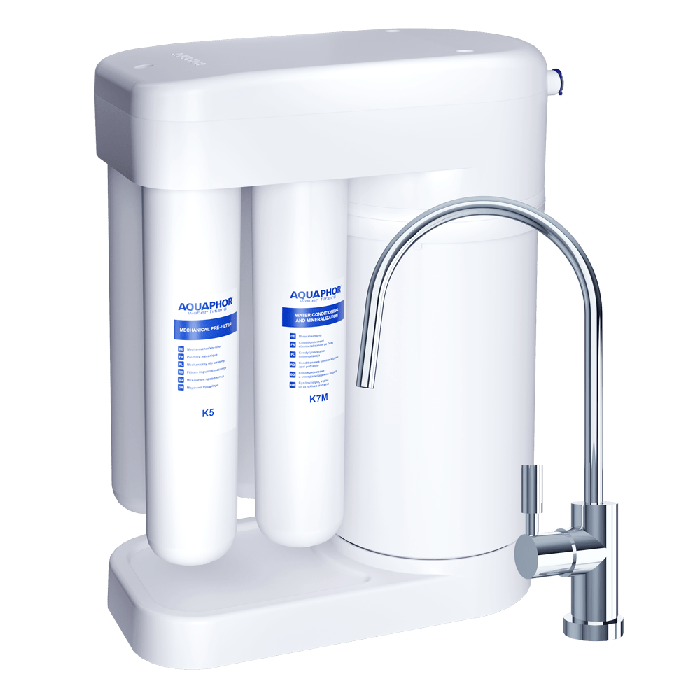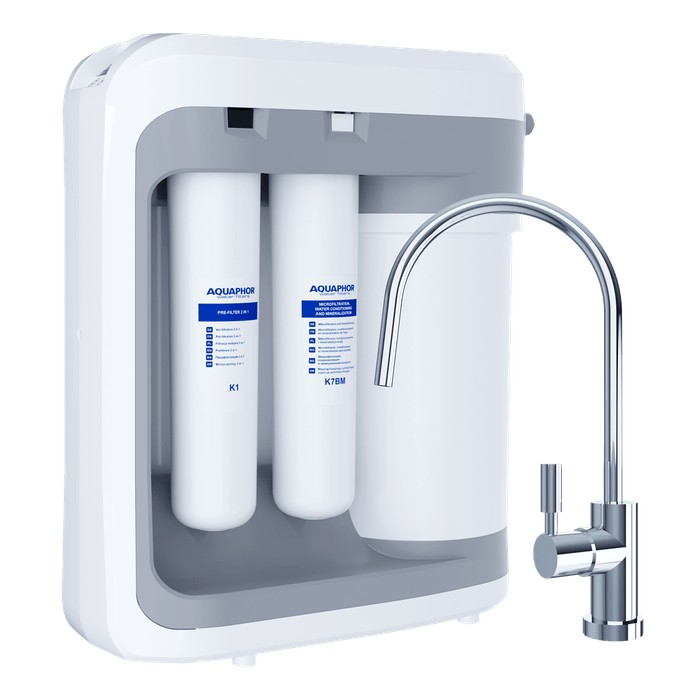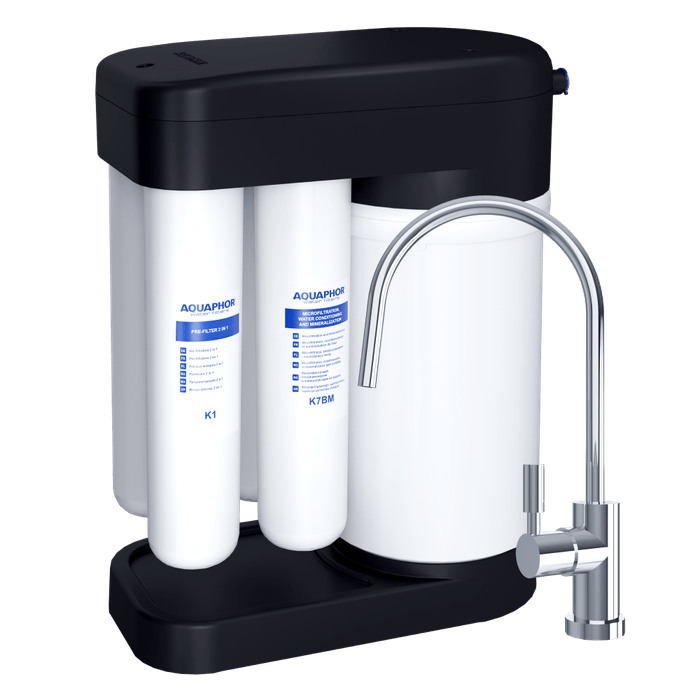 RO-101S
RO-101S
A versatile reverse osmosis system that relieves your water from contaminants and enriches it with healthy minerals.
Choose a water filter tap
 RO-202S
RO-202S
Intellectual and fully automatic reverse osmosis system with extreme water efficiency.
 RO-102S EU
RO-102S EU
Compact, highly productive and water-efficient RO system with 5 liter storage tank
Reverse osmosis is a technology used by bottled water and food manufacturers around the world. Home reverse osmosis filters (membrane water purifiers) make tap water of any quality absolutely safe.
It’s much more budget-friendly to install a reverse osmosis water purification system right in the kitchen under the sink than to buy bottled water. The cost of water you get at home is at least 10 times less.
Due to the pipeline pressure, water is pressed through the reverse osmosis membrane. It does not let any other substances through except water, therefore harmful impurities and hardness salts remain on its surface, and then are washed off into the sewer (drain water). Reverse osmosis is based on the natural biological process called osmosis: it helps to saturate the cells of plants, animals and humans with useful substances (water carries them through the cell membrane).
RO filter makes water safe, eliminating any contaminants. It even removes pesticides, nitrates, hormones, antibiotics, bacteria and viruses. Hospitals and dialysis stations use reverse osmosis systems to remove the most difficult-to-separate impurities (their trace amounts can be dangerous). Because of its utter safety, water purified by reverse osmosis filters is best suited for the baby food.
The membrane in a reverse osmosis system does not let any hardness salts (calcium and magnesium, which are the main reason of scale formation and equipment breakdown) through. Therefore, reverse osmosis is the most effective means of hard water purification. Compare: in sorption filters, softening cartridges need to be changed every 1-2 months, and in reverse osmosis systems, you get rid of scale for the entire membrane life period (1.5-2 years).
NB: It is best to prepare food and drinks in soft water (with low mineral content). Hard water is not good for cooking, because the excess of minerals leads to poor extraction of flavor. The mineral-free water tastes unusual.
A high-quality home reverse osmosis system deeply purifies water and enriches it with the necessary amount of minerals (e.g., magnesium). It also neutralizes water’s pH level.
Water with low mineral content and neutral pH is good for health. It is suitable for people with disorders of acid-base balance and sensitive digestion. Moderately mineralized water speeds up the removal of toxins, helps to digest food and enjoy its taste.
Reverse osmosis water purification systems remove particles that are 100,000 times smaller than the thickness of a human hair (up to 0.001 microns). Such deep filtration takes time. That’s why almost all models include a storage tank for pure water - so that you don't have to wait filling a kettle or saucepan.
If space under the sink is limited, it is better to choose a system with a compact built-in tank for clean water.
In a standard under-sink reverse osmosis system, the water in a tank is enough for a family of 5-6 people. It is essential that it fills up quickly, especially if you are cooking dinner for relatives or friends.
If you often cook at home for a large family and like to have guests, choose a water filter that can fill 5 liters of pure water in no longer than an hour.
The water collection rate depends on the reverse osmosis system design and the pressure in water pipes. The higher it is, the faster and more efficient is filtration, and the less water it takes to prepare a liter of pure drinking water. At a pressure below 3.5 atm, a classic reverse osmosis filter needs an electric pump to increase the pressure. Otherwise, the filtered water will accumulate in the tank too slowly, and some of the water will constantly flow into the drain.
NB: In many homes, the pipeline pressure is quite low. If cold water comes out of the tap too slowly, this is exactly the case of low pressure. Consider this before buying a filter. It’s better to pick models that work stably at low water supply pressure, and drain as little water as possible into the sewerage system.
AQUAPHOR has developed and patented the water-on-water tank technology for reverse osmosis systems. Models that include water-water tank (for example, DWM-101S Morion) have the following features:
The water filtration rate is higher than in classical RO systems: a 5 liter tank is filled in about 40-60 minutes (the speed depends on the pipeline pressure).
It is compact and can be conveniently placed under the sink, since the tank is built into the filter housing. There will be a room for both the trash can and the cleaning products under your sink.
Budget-friendly solution. For 1 liter of purified water, about 5 liters of tap water are used to flush harmful impurities off the membrane. A classic reverse osmosis system needs twice more water (8-15 liters) for that. The less water goes into drain, the less often pre-filtration cartridges need to be changed. These cartridges are present in every reverse osmosis filter, they protect the membrane from chlorine and remove rust, sand and silt.
Autonomous operation. A system doesn’t need a pump or electricity, since a water supply pressure of 2 atm is sufficient. Classic reverse osmosis water purification systems (with water-on-air tank) require a pressure of at least 3.5 atm or the installation of an electric pump.
The reliability and stability of a filter depends on the performance of each cartridge. So don’t forget to change cartridges on time. Register your water filter and we will remind you about the cartridge replacement.